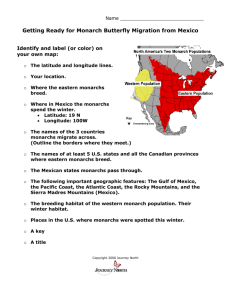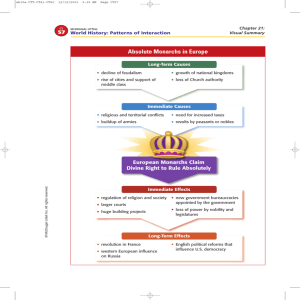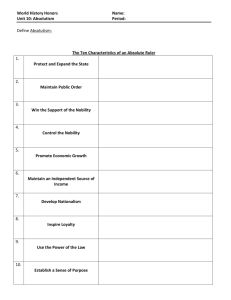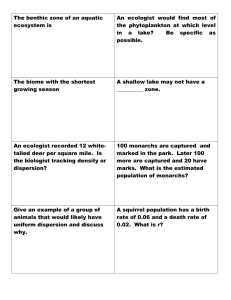AN EVALUATION OF THREE METHODS OF COUNTING MIGRATING MONARCH A
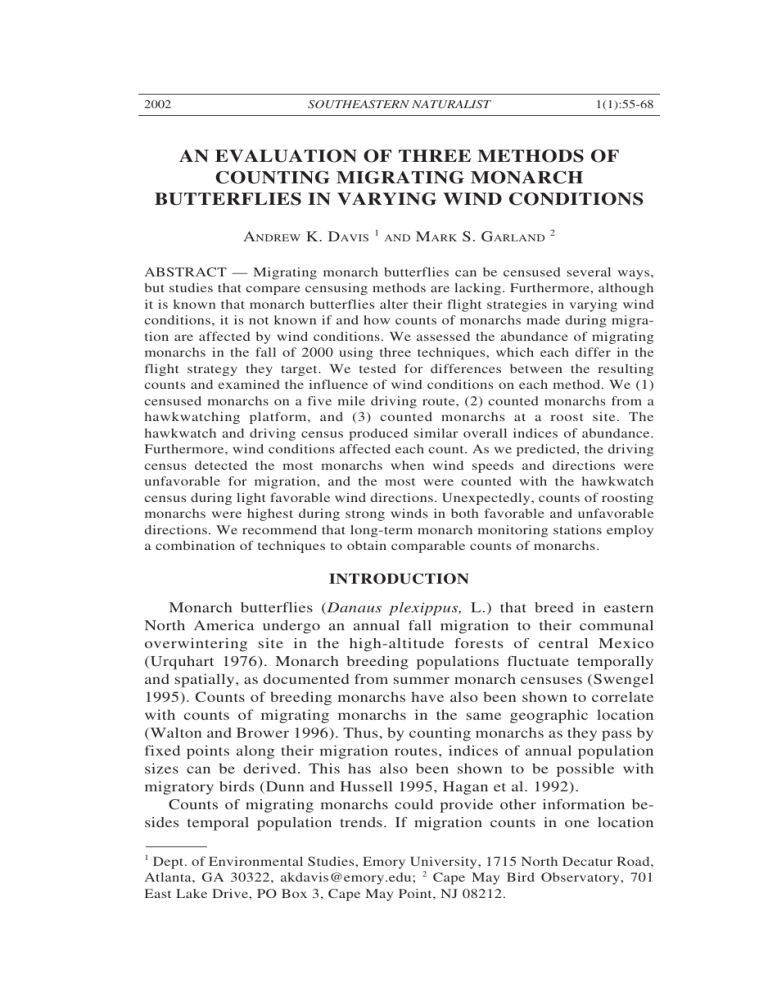
2002 SOUTHEASTERN NATURALIST 1(1):55-68
AN EVALUATION OF THREE METHODS OF
COUNTING MIGRATING MONARCH
BUTTERFLIES IN VARYING WIND CONDITIONS
A
NDREW
K. D
AVIS
1
AND
M
ARK
S. G
ARLAND
2
ABSTRACT — Migrating monarch butterflies can be censused several ways, but studies that compare censusing methods are lacking. Furthermore, although it is known that monarch butterflies alter their flight strategies in varying wind conditions, it is not known if and how counts of monarchs made during migration are affected by wind conditions. We assessed the abundance of migrating monarchs in the fall of 2000 using three techniques, which each differ in the flight strategy they target. We tested for differences between the resulting counts and examined the influence of wind conditions on each method. We (1) censused monarchs on a five mile driving route, (2) counted monarchs from a hawkwatching platform, and (3) counted monarchs at a roost site. The hawkwatch and driving census produced similar overall indices of abundance.
Furthermore, wind conditions affected each count. As we predicted, the driving census detected the most monarchs when wind speeds and directions were unfavorable for migration, and the most were counted with the hawkwatch census during light favorable wind directions. Unexpectedly, counts of roosting monarchs were highest during strong winds in both favorable and unfavorable directions. We recommend that long-term monarch monitoring stations employ a combination of techniques to obtain comparable counts of monarchs.
INTRODUCTION
Monarch butterflies (Danaus plexippus, L.) that breed in eastern
North America undergo an annual fall migration to their communal overwintering site in the high-altitude forests of central Mexico
(Urquhart 1976). Monarch breeding populations fluctuate temporally and spatially, as documented from summer monarch censuses (Swengel
1995). Counts of breeding monarchs have also been shown to correlate with counts of migrating monarchs in the same geographic location
(Walton and Brower 1996). Thus, by counting monarchs as they pass by fixed points along their migration routes, indices of annual population sizes can be derived. This has also been shown to be possible with migratory birds (Dunn and Hussell 1995, Hagan et al. 1992).
Counts of migrating monarchs could provide other information besides temporal population trends. If migration counts in one location
1 Dept. of Environmental Studies, Emory University, 1715 North Decatur Road,
Atlanta, GA 30322, akdavis@emory.edu; 2 Cape May Bird Observatory, 701
East Lake Drive, PO Box 3, Cape May Point, NJ 08212.
56 Southeastern Naturalist Vol. 1, No. 1 within the migration route could be compared to that of another, our understanding of monarch migration could be vastly improved. Only when many sites are operated simultaneously throughout the migration route, with each site using standardized methods of counting, can we answer certain important questions such as where mortality occurs during migration, where certain key areas with large monarch concentrations are located, and conversely what areas or habitats monarchs tend to avoid.
Furthermore, areas of monarch concentration may contain habitats or resources that may be crucial for successful migration. These areas are known to be important for successful bird migrations (e.g., Hutto 1998).
Daily counts of monarchs made at several migration monitoring sites would only be comparable if the monarchs being observed migrate through each site in the same manner each day. However this may not always be so, as previous research has demonstrated that monarchs in flight are greatly affected by wind conditions (Gibo and Pallett 1979). It has been shown that monarchs take advantage of tailwinds during migration by altering their flight behavior to that of soaring at high altitudes (Gibo and Pallett 1979, Schmidt-Koenig 1985). By soaring during light tailwinds, monarchs can reduce energetic costs of flight (Gibo and
Pallett 1979) and increase transit times (Garland and Davis 2002).
Furthermore, during headwinds and lateral winds monarchs have been found to fly close to the ground and in the lee sides of protective structures (Schmidt-Koenig 1985). Headwinds and lateral winds are also known to cause monarchs to stop migrating and accumulate in areas on the ground until conditions become favorable again (Scmidt-Koenig
1985). Finally, wind speeds are known to affect monarch flight strategies as well. Monarchs tend to fly lower or not at all during strong winds, even if the direction is favorable, and tend to fly higher during light winds (Schmidt-Koenig 1985).
Although it is known that wind conditions affect monarch flight strategies, there is no literature addressing how wind affects counts of monarchs made at migration monitoring sites. Since wind speeds and directions affect the altitude and behavior of monarch migration, counting methods which target low-flying monarchs would be ineffective during tailwinds and/or light wind speeds, which both promote highaltitude flight. Alternatively, counts of high-altitude monarchs would only be useful when wind conditions promoted such flight. Finally, counts of monarchs on the ground at roost sites or accumulation areas made during headwinds or strong wind speeds (conditions not conducive to migration) are likely to differ from those made during tailwinds or light windspeeds (conducive to migration). We addressed each of these issues in the present study.
We simultaneously used three techniques of assessing monarch abundance during one migration season, each of which samples different
2002 A.K. Davis and M.S. Garland 57 migration strategies, to determine: (1) if these methods produce similar indices of monarch abundance; and (2) how the resulting counts are affected by wind conditions. We used one technique that samples lowflying monarchs, one technique to count high-altitude monarchs, and one method that counts grounded monarchs at a roost site. We then examined how the daily wind strength and direction affected each daily count.
Since monarchs tend to fly low and are more likely to stop migrating during unfavorable wind conditions and soar high during favorable conditions (Gibo and Pallett 1979, Schmidt-Koenig 1985) we made two predictions of the effects on wind on our censuses. We predicted that:
(1) counts of low-flying monarchs made by the driving census and counts of roosting monarchs would be highest during strong, unfavorable wind directions; and (2) counts of high-flying monarchs made by the hawkwatch census would be highest with light wind speeds in favorable directions.
STUDY SITES
Our study sites were located at the extreme southern end of the
Delmarva Peninsula, which includes parts of the states of Delaware,
Maryland, and Virginia, with Virginia’s eastern shore making up the southern portion (Fig. 1). Our study locations were the Coastal Virginia
Wildlife Observatory (CVWO) at Kiptopeke State Park, approximately
Figure 1. Map showing location of the study sites, the Coastal Virginia Wildlife
Observatory (CVWO) and the Eastern Shore of Virginia National Wildlife
Refuge (ESVNWR), both indicated by the circle. Site where wind data was recorded also shown (star).
58 Southeastern Naturalist Vol. 1, No. 1
5 km from the southern tip of the peninsula; the Eastern Shore of
Virginia National Wildlife Refuge (ESVNWR), which encompasses most of the southern 2-3 km of land on the peninsula; and the five km area immediately north of ESVNWR (Fig. 1). This area is ideal for studies of monarch migration, as there is no summer breeding population of monarchs according to breeding butterfly censuses (Garland, unpubl. data). Therefore it was likely that any monarch seen in the area in the fall was a migrant. Also, the geographic funneling effect of the
Delmarva Peninsula concentrated large numbers of monarchs at these sites (Garland and Davis 2002), thus enabling large numbers of monarchs to be censused in one season.
METHODS
We surveyed migrating monarch butterflies in September and October of 2000. Monarchs were surveyed by three methods. The first method (hereafter called driving census) follows a technique described by Walton and Brower (1996), which was adapted from Pollard (1977), where a five mile transect (roadway) through the study area was driven by one person three times daily and all monarchs seen were counted.
The census was driven at 10:00 am, 1:00 pm, and 4:00 pm each day and covered several different habitats at our site, including beach, sand dunes, riparian forest, suburban, and agricultural areas. The roads we chose for our transect route roughly paralleled the north-south orientation of the peninsula, such that for the first half of the census the observer is driving north, and for the second half, driving south along a different route. This north-south orientation of the transect route allowed the driving observer to spot numbers of monarchs (which would be flying south) equally easily on either side of the road. The speed of the vehicle did not exceed 25 km/hr throughout the census. This technique, although useful to determine the spatial distribution of monarchs across many different habitats, targeted mainly low-flying monarchs as it was only possible to see monarchs flying on either side of the vehicle.
Our second method (hereafter called hawkwatch census) was a novel approach at counting migrating monarchs, where we counted all monarchs seen from the CVWO hawkwatching platform in Kiptopeke State
Park. The platform is approximately 5 meters above ground, with good visibility in 360 degrees. During the fall, CVWO employs a hawkwatcher to count migrating raptors from this platform daily. At times during the fall, hundreds of migrating raptors fly over this platform, heading south.
We had noticed that monarchs also fly over this platform each fall, often in large numbers, thus allowing an observer on the platform to derive daily counts of monarch migration. For our study, the CVWO hawkwatcher counted any monarchs seen during the raptor count.
2002 A.K. Davis and M.S. Garland 59
Although not specifically looking for monarchs, the standard practice of a hawkwatcher is to continuously scan the sky with high power binoculars for soaring raptors, making it easy to spot high-flying monarchs soaring overhead. This method targeted mainly high-altitude monarchs, as the hawkwatcher spent most of the time scanning the overhead sky. We have found that monarchs can be easily spotted from this platform. Further, although other butterfly species are common in the area where the platform is located, few other butterfly species commonly fly high over the platform. The daily monarch counting period was divided into three segments for this method – from 1 hour after sunrise until 10:00 am, from 10:30 am to 1:00 pm, and from 1:30 pm to 4:00 pm.
Our final method (hereafter called roost census) counted all monarchs seen at a known accumulation site once a day during the migration period. The site is a 1 hectare area located at the extreme southern tip of the Delmarva Peninsula, on a section of land owned and protected by the
Eastern Shore of Virginia National Wildlife Refuge (Garland and Davis
2002). This point of land represents one of the last places where monarchs can stop and rest before having to cross the Delaware Bay. We had found previously that monarchs tended to concentrate in this area on certain days and roost in two to three specific trees each fall (Garland and Davis, in press). We visited this site daily just before dusk for approximately 20 min, or on some occasions, the next morning just after sunrise, since monarchs do not fly at night (Brower 1995). On each visit, the number of monarchs seen roosting in the area or flying in the vicinity of the roost trees was recorded (or estimated when numbers were larger than 100 individuals). We hoped that by counting the monarchs that accumulated at the end of the day on the end of the peninsula, we could obtain numbers similar to those obtained during the day by the other two methods.
We obtained wind condition data, consisting of wind directions and speeds, from a weather station located on the eastern side of the peninsula approximately 100 km north of our site (Fig. 1). Although this station was not located at our study site we found that wind conditions recorded at this location were similar to those recorded at our site, and moreover, are representative of the general conditions over most of the southern peninsula (Davis and Garland, unpubl. data). Furthermore, by using data from this site, we could obtain wind condition data at high altitudes, which was not possible to obtain elsewhere. For this study we obtained daily wind condition data from several heights ranging from 13 to 1000 m. Since the range of wind speeds we observed during our study ranged from 5 to 40 km/hr, we arbitrarily classified all winds over 25 km/hr as strong, and under 25 km/hr as light. This cut-off point of 25 km/hr allowed roughly equal sample sizes of each wind speed class.
60 Southeastern Naturalist Vol. 1, No. 1
There is little documented evidence of what wind speeds are too strong for monarch migration, except for observations by Gibo and Pallett
(1979), who estimated that wind speeds of 30 km/hr or more were too strong for monarch flight. Thus, our arbitrary 25 km/hr cut-off was biologically meaningful.
We further assumed that unfavorable wind directions for monarchs migrating south-southwest along the east coast of North America included winds from the south, southeast, southwest, west, east, and northwest. Conversely, we assumed favorable wind directions included winds from the north and northeast.
To initially compare the counts of each method, we performed
Pearson Correlations on all possible combinations of methods. To test our predictions of wind effects, we first created four groups of wind categories: days with favorable wind directions and strong winds, days with favorable wind directions and light winds, days with unfavorable directions and strong winds, and days with unfavorable directions and light winds. The daily counts made during each of these days were then averaged for each wind category and for each of the three censusing methods. Since the total number of days where monarchs were observed over the entire season was only 27, the sample sizes in each of the four wind categories were too small to statistically test our hypotheses concerning wind effects on monarch counts. Thus, we based our conclusions concerning wind effects only on graphical comparisons of these mean daily counts of each method made during all wind conditions.
In all tests, results were considered significant when p<0.05, and marginally significant when p<0.10.
RESULTS
Overall, the total number of monarchs counted with the driving census during the months of September and October was 91 individuals.
A total of 1033 were seen with the hawkwatch census, while 1243 were seen with the roost census. The large discrepancy between the total number of monarchs counted by the hawkwatch (1033) and the driving census (91) for the season is almost entirely due to the longer daily duration of the hawkwatch than that of the driving census, which usually took approximately 15 minutes, three times daily. A better comparison of these two methods is to compare counts of monarchs seen per hour, following Walton and Brower (1996). Doing so for our data yielded an overall average of 3.44 monarchs per hour for the entire season using the driving census method, versus 3.23 monarchs per hour for the same time period using the hawkwatch census. For all further comparisons and graphs involving hawkwatch and driving census counts, we used the daily rates (# monarchs/hr).
2002 A.K. Davis and M.S. Garland 61
Figure 2. Daily counts of monarch abundance using (A) driving census, (B) hawkwatch census, and (C) roost census. For driving and hawkwatch censuses, the daily rates (# monarchs/hr) are shown
62 Southeastern Naturalist Vol. 1, No. 1
Figure 3. Scatterplot comparisons of each census method. All daily counts converted to ranks. Pearson correlation coefficients of each comparison shown.
2002 A.K. Davis and M.S. Garland 63
Figure 4. Comparisons of the average daily rates of monarchs in all possible wind combinations with the (A) driving census, (B) hawkwatch census, and (C) roost census. Standard error bars shown. Strong winds were winds >25 km/hr.
Favorable wind directions included north, northeast, and north-northeast.
64 Southeastern Naturalist Vol. 1, No. 1
The seasonal distribution of monarchs at our study site derived by all three methods is presented graphically (Fig. 2). Each method detected few monarchs arriving at our site before late September. The bulk of the movement through our study site in the 2000 season was from September 25 to October 28.
Since the roost counts were absolute numbers and the hawkwatch and driving censuses contained rates per hour, we used the ranks of the counts for the correlations of each method (Fig. 3). The methods that were most closely correlated were the hawkwatch and driving censuses
(R= 0.57, p=0.002). There was a significant correlation between the roost census and the hawkwatch census (R=0.4, p=0.04), and a marginally significant correlation between the roost census and the driving census (R=0.34, p=0.09).
Effects of wind condition
The wind conditions and the daily rate or count of monarchs seen by the three methods from September 25 to October 30 are presented in
Table 1. Days in which <10 monarchs were seen are excluded to ensure that we were only testing days in which monarchs were actively migrating through our site. This resulted in 27 days in which monarchs were migrating through our study site.
Our predictions held true for the driving census and hawkwatch census. Graphical comparisons showed that wind conditions affected these methods in the predicted directions. On average, the most monarchs were counted with the driving census during strong, unfavorable winds (Fig. 4A). Conversely, the hawkwatch counted the most mon-
Table 1. Daily counts of monarchs from Sept. 25 to Oct. 30, 2000 by each method, with daily overall wind direction shown. Days when <10 monarchs were seen are omitted.
Date Wind Speed Census 1 Hawk 1 Roost Date Wind Speed Census 1 Hawk 1 Roost
(km/hr) (km/hr)
27-Sep N
28-Sep N
26.6
15.8
29-Sep NE 24.1
2-Oct NNE 39.9
3-Oct WNW 33.7
4-Oct SW 14.2
5-Oct W
7-Oct N
10.2
43.3
9-Oct N
10-Oct W
44.6
40.5
11-Oct NW 35.9
12-Oct N 20.7
13-Oct N 25.1
14-Oct NW 17.3
0.0
1.3
1.3
1.3
10.7
14.0
5.3
2.7
0.0
0.0
5.3
3.2
100 15-Oct NW 27.2
9.3
37.3
75 16-Oct NE 6.2
5.3
5.3
6.2
1.7
38
17-Oct
18-Oct
ENE
E
36.5
18.3
3.9
4.7
1.3
5.7
3
0
0
150
19-Oct
20-Oct
21-Oct
22-Oct
NW
NNE
SW
NE
34.7
11.5
25.1
32.8
1.6
0.7
0.3
45 23-Oct ENE 29.4
40 25-Oct NNE 17.0
2.1
100 26-Oct SE
40 32.2
5.6
165 28-Oct NW 46.4
3.6
40
27-Oct NE
13.0
2.0
0.0
0.0
2.0
2.0
28.0
11.9
218
5.3
3.8
4
0.0
4.0
0.4
0.0
8
8
8.0
4.0
10.0
0.0
3.0
6.2
4.2
0.3
35
20
50
20
0.5
1.7
1.3
5.2
0.3
20
10
15
20
10
1 Daily rate of monarchs, in # monarchs/hr.
2002 A.K. Davis and M.S. Garland 65 archs on average during days when the wind was light, and in a favorable direction (Fig. 4B). Our prediction of the effect of wind conditions on roosting monarchs did not hold true. The highest average number of monarchs were counted during strong, but favorable winds (Fig. 4C). A large number were also counted during strong unfavorable wind directions, as predicted. Thus, wind strength appeared to influence monarch roosting no matter what the direction.
DISCUSSION
Comparison of methods
Each method of counting migrating monarchs showed somewhat similar temporal distributions of monarchs. Each showed that there were two main pulses in 2000, one in late September, and one in mid October
It is also clear from all three methods that monarchs did not start arriving in appreciable numbers to our site until late September. Moreover, the driving census and the hawkwatch census produced generally similar overall numbers of monarchs for the entire migration period, if the overall average rates (3.44 monarchs/hour vs. 3.23 monarchs/hour, respectively) are compared. These two methods were also roughly correlated. Thus each of these two methods was useful in reporting both the seasonal distribution of monarchs and the total numbers of monarchs passing the site in a season.
In contrast, the counts made at the roost site were weakly correlated with the hawkwatch and driving censuses. Although this result indicates that counts of roosting monarchs may not be reliable indicators of daily monarch abundance during migration, we stress here that such counts are nonetheless important as they provide information on where monarchs stop during migration and what conditions cause them to do so.
Where monarchs choose to stop during migration and what causes them to do so remain unanswered questions thus far.
Effects of wind condition
Even though our data was limited and based solely on one migration season, the daily counts made by the driving census, the hawkwatch census, and the roost censuses all appeared to be influenced by wind conditions. Although we could not perform statistical tests to confirm these trends, our graphs indicated that strong winds in unfavorable directions resulted in more monarchs being counted by the driving census and the roost census. Thus during these conditions, monarchs tended to fly lower, were subsequently recorded more by the driving census, and during favorable light winds, tended to soar high, and were recorded more often by the hawkwatch census. They also accumulated
66 Southeastern Naturalist Vol. 1, No. 1 on the ground at the roost site at the end of the peninsula during strong winds (in both favorable and unfavorable directions) and were recorded more by the roost census than during other wind conditions.
The fact that the most monarchs were recorded at the roost site when the wind was strong and in favorable directions was unexpected. Few monarchs were actively migrating during these conditions, as recorded by both the hawkwatch and driving censuses. Where did all of the roosting monarchs come from during these days? One explanation is that these monarchs had arrived at the southern tip in previous days but had not attempted to cross the Delaware Bay at that time. Thus they may have become concentrated at the roost site over a number of days in these situations, leading to the large roost counts. This then, could explain why the roost census was not highly correlated with either of the other census methods. On days when the wind conditions were unfavorable for continued migration, monarchs tended to accumulate at the roost site over several days. On October 10 and 11, for example, the winds were strong and in unfavorable directions. On those days, the roost census recorded 40 and 100 monarchs respectively, while few actively migrating monarchs were seen with the driving and hawkwatch censuses. Thus, in this instance, the roost census was counting monarchs that had become trapped at the southern tip of the peninsula and were waiting for favorable wind conditions.
In support of this, Schmidt-Koenig (1985) found that monarchs were reluctant to cross water barriers and often accumulated at beach sites and shorelines. Future research at this roost site could focus on determining how long monarchs generally stay in this area during a typical stopover and how wind conditions affect the length of stay.
We can gain some insight into this issue by drawing on the results of similar research on bird migration. It is known that whether a bird suspends its migration and where it sets down is influenced by many factors, including the bird’s energy stores (e. g., Morris 1996), the suitability of the site (Moore et al. 1995, Moore and Simons 1992), and opposing headwinds (Davis 1999). Similar issues may be involved in determining whether a monarch stops at the southern end of the Delmarva Peninsula.
This study showed that strong winds in favorable and unfavorable directions caused monarchs to accumulate at the roost site. Additional study will be required to determine if those monarchs that stop and roost are forced to because of depleted energy reserves. If either case were true, then daily counts of monarchs at such roost sites would not necessarily provide accurate samples of the migrating monarch population that day.
Rather, they would only be sampling those monarchs that were forced to land by energetic or environmental constraints.
Our observations in this study are consistent with Gibo and Pallett
(1979) and Schmidt-Koenig (1985). These studies showed that wind
2002 A.K. Davis and M.S. Garland 67 conditions can influence monarch flight strategies. Our finding that wind conditions in turn influence monarch censusing methods has important implications for monarch monitoring stations. In order for comparisons between different geographic sites throughout the migration route to be made, the censusing methods at each station must be standardized. If the wind conditions at one site differ from that of the other, the resulting counts would differ only because the monarchs reacted to this difference in wind conditions.
Researchers and organizations planning to monitor migrating monarchs should consider which method would be most useful at their study site. There are logistical advantages and disadvantages to each method.
The driving census needs to only be done 3 times each day, while the hawkwatch census requires more hours. However more monarchs can be sighted with the hawkwatch method. Roost counts need only be done once a day, but may not accurately sample the entire migration. However, roost counts can also provide important information on monarch stopover or roost site dynamics. Also, each method also only targets a certain flight strategy. We suggest that an obvious compromise would be to adopt a combination of techniques to sample high- and low-flying or grounded monarchs. Furthermore, we strongly recommend that monitoring stations maintain detailed records of wind conditions during the migration. The present study demonstrates the importance of doing so.
Adopting a multiple-technique approach to censusing migrating animals is not a novel idea. Bird observatories in Canada have adopted a similar strategy of combining multiple techniques to monitor migrating birds (Dunn and Hussell 1995), which has already shown its value in making geographic comparisons of certain aspects of bird migration
(Dunn 2000). We propose that a similar strategy to monitor monarch migration would provide a more complete picture of the migration than using one method alone. When counts from several locations along the migration route are standardized and compared, our understanding of the unique migration of monarch butterflies will no doubt improve greatly.
ACKNOWLEGDEMENTS
We are indebted to a number of people who assisted throughout this study:
Paige Cunningham, Brian Sullivan, Stephanie Mason, Lynn Davidson, Hal
Wierenga, George Armistead, Harry Armistead, and Liz Armistead. We especially thank Calvin Brennan for counting monarchs on the hawkwatch. We also thank the staffs of the Kiptopeke State Park, CVWO, ESVNWR and Mr. Clement M. Pruitt, for permitting access to land. Sonia Altizer provided helpful comments on all stages of the manuscript. Financial support was provided by a
USFW grant to MG. Logistic support was provided by the Coastal Virginia
Wildlife Observatory.
68 Southeastern Naturalist
LITERATURE CITED
Vol. 1, No. 1
BROWER, L.P. 1995. Understanding and misunderstanding the migration of the monarch butterfly (Nymphalidae) in North America, 1857-1995. Journal of the
Lepidopterists’ Society 49:304-385.
DAVIS, A.K. 1999. The stopover ecology of landbirds on Bon Portage Island, Nova
Scotia. MSc. Thesis. Acadia University, Wolfville, NS, Canada.
DUNN, E.H. 2000. Temporal and spatial patterns in daily mass gain of Magnolia
Warblers during migratory stopover. Auk. 117(1):12-21.
DUNN, E.H., and D.J.T. HUSSELL. 1995. Using migration counts to monitor landbird populations: review and evaluation of current status. Pp. 43-88, In D. M.
Power (Ed.), Current Ornithology, Vol 12. Plenum Press, New York, NY.
GARLAND, M.S., and A.K. DAVIS. 2002. An examination of Monarch Butterfly
(Danaus plexippus) autumn migration in coastal Virginia. American Midland
Naturalist 147:170-174.
GIBO, D.L., and M.J. PALLETT. 1979. Soaring flight of monarch butterflies
Danaus plexippus (Lepidoptera: Danaidae), during the late summer migration in southern Ontario. Canadian Journal of Zoology 57:1393-1401.
HAGAN, J.M., III, T.L. LLOYD-EVANS, J.L. ATWOOD, and D.S. WOOD. 1992.
Long-term changes in migratory landbirds in the northeastern United States: evidence from migration capture data. Pp. 115-130, In J.M. Hagan III and D.W.
Johnston (Eds.). Ecology and Conservation of Neotrapical Migrant Landbirds.
Smithsonian Institution Press, Washington, DC.
HUTTO, R.L. 1998. On the importance of stopover sites to migrating birds. Auk
115(4):823-825.
MOORE, F.R., S.A. GAUTHREAUX, Jr., P. KERLINGER, and T.R. SIMONS.
1995. Habitat requirements during migration: important link in conservation. Pp.
121-144, In T.E. Martin and D.M. Finch. (Eds.). Ecology and Management of
Neotropical Migratory Birds. Oxford University Press, New York, NY.
MOORE, F.R., and T.R. SIMONS. 1992. Habitat suitability and stopover ecology of neotropical landbird migrants. Pp. 345-355 In J.M. Hagan, III, and D.W.
Johnston. (Eds.). Ecology and Conservation of Neotropical Migrant Landbirds.
Smithsonian Institution Press, Washington, DC.
MORRIS, S.R. 1996. Mass loss and the probability of stopover by migrant warblers during spring and fall migration. Journal of Field Ornithology 67(3):456-462.
POLLARD, E. 1977. A method for assessing changes in the abundance of butterflies. Biological Conservation 12:115-134.
SCHMIDT-KOENIG, K. 1985. Migration strategies of monarch butterflies (Danaus
plexippus (L.); Danaidae; Lepidoptera). Pp. 786-798, In M.A. Rankin (Ed.).
Migration: Mechanisms and Adaptive Significance. University of Texas Contributions to Marine Science 27 (Supplement).
SWENGEL, A.B. 1995. Population fluctuations of the monarch (Danaus plexippus) in the 4 th of July Butterfly Count 1977-1994. American Midland Naturalist
134(2):205-213.
URQUHART, F. 1976. Found at last, the monarch’s winter home. National Geographic 150:160-173.
WALTON, R.K., and L.P. BROWER. 1996. Monitoring the fall migration of the monarch butterfly Danaus plexippus L. (Nymphalidae: Danainae) in eastern
North America: 1991-1994. Journal of the Lepidopterists’ Society 50(1):1-20.


